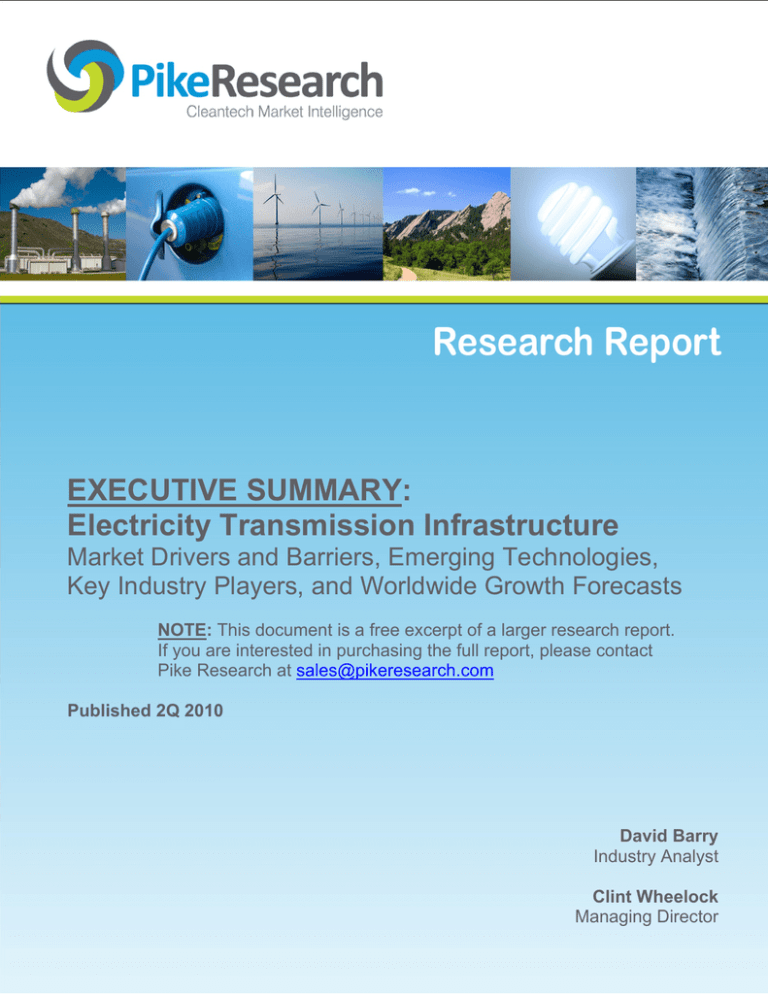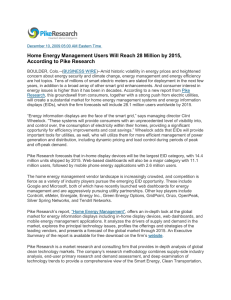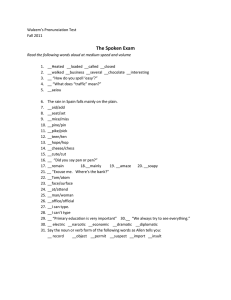
EXECUTIVE SUMMARY:
Electricity Transmission Infrastructure
Market Drivers and Barriers, Emerging Technologies,
Key Industry Players, and Worldwide Growth Forecasts
NOTE: This document is a free excerpt of a larger research report.
If you are interested in purchasing the full report, please contact
Pike Research at sales@pikeresearch.com
Published 2Q 2010
David Barry
Industry Analyst
Clint Wheelock
Managing Director
Electricity Transmission
Infrastructure
Section 1
EXECUTIVE SUMMARY
The electric transmission grid is a crucial component of modern society. Much like the
cornerstone of a building, transmission is the foundation that supports activity in virtually all
areas of the energy sector. In order to reap the full benefits of renewable energy and
smart grid technologies, the capacity and information-carrying ability of transmission
systems must be increased substantially. Indeed, the global economy will be inhibited if
the grid cannot keep pace with technology advances, changing demographics, and the
competitive energy markets.
In the United States, there is consensus that increasing investment in the transmission
infrastructure is a critical priority. After decades of neglect, the electric power industry
started addressing the country’s transmission issues in the late 1990s. As directed by the
Energy Policy Act of 2005, the Federal Energy Regulatory Commission (FERC) has been
taking steps to create incentive-based rates of return for transmission projects. Both
national political parties support the development of the grid, and a recent focus on
developing smart grid capabilities will add momentum to this trend. Considering that
support for transmission development has spanned 20 years and four presidential
administrations, it seems likely that this policy trend will continue.
Many forces are influencing investments in the transmission market. Pike Research’s
analysis finds that four market drivers have the most impact on the development of
transmission projects:
Reliability/capacity enhancements – This is the constant driver of the transmission
market. Reliability projects are ongoing at many U.S. utilities and, as assets strain to
accommodate increasing competition, new transmission is needed to ensure reliability.
Renewable portfolio standards (RPS) – State RPS mandates have resulted in a
dramatic increase in renewable generation (predominantly wind power). The inability of
the current transmission infrastructure to handle this new and frequently distant
generation is the biggest factor driving the development of the grid.
Economic projects – Transmission congestion and the development of competitive
energy markets are increasing the economic justifications for new transmission systems.
Replacement of infrastructure – By some estimates, one-third of the U.S. grid is at or
near the end of its projected lifespan. As the nation builds new capacity, it must also
replace a considerable amount of its existing transmission capacity.
However, opposition to new transmission projects is common. The biggest obstacles are
issues related to siting new lines and the allocation of project costs. The FERC is unlikely
to utilize its “backstop” siting authority and this issue will continue to be problematic. With
regard to cost allocation, some progress has been made in developing models that do a
better job at calculating the benefits of transmission projects. Pike Research believes that
the FERC will replace its current case-by-case cost allocation approach with a more
consistent formula by the end of 2011.
© 2010 Pike Research LLC.
All Rights Reserved. This publication may be used only as expressly permitted by license from Pike Research LLC and may not otherwise be accessed or used, without the
express written permission of Pike Research LLC.
1
Electricity Transmission
Infrastructure
The same forces that are stimulating overall investment in the electric power industry have
fueled technological innovation in the transmission sector. These innovations have
resulted in the increased use of several key transmission technologies:
Extra high-voltage and ultra high-voltage lines
High-voltage direct current
High-temperature superconducting cable and electronic components
Fault current limiters
Power electronics
Wide area monitoring systems and phasor measurement units
Public policy, market forces, and technological innovation have all impacted the
transmission sector. Transmission has become more competitive and more adaptable.
Moreover, there is a greater emphasis on specialized applications of technology.
The electric power industry in every part of the world is trying to become more efficient,
reliable, and (in most areas) cleaner. The transmission market varies significantly by
region. In some areas, huge amounts of capital are being spent to modernize and expand
transmission infrastructure. Some of the largest and fastest-growing countries (e.g., China,
India, and Brazil) are building national transmission systems for the first time. It is not
unusual for the dominant country in a region to invest as much as all of the other countries
in the region combined. This uneven distribution of expenditures is an example of the
competing infrastructure needs in many countries.
Pike Research forecasts that the worldwide transmission market will grow by a compound
annual growth rate (CAGR) of 1.5% during the forecast period (2010-2020). The majority
of this growth will occur during the first half of the period, leading to modest or even
declining growth rates for some regions in the second half of the period.
In the United States, the electric power industry has committed substantial resources to
expand and modernize its grid. Pike Research forecasts an overall growth rate for
transmission expenditures of 1.3% for the period from 2010 to 2020. The CAGR for the
first half of the forecast period is expected to be 3.5%, reflecting the nation’s commitment
to renewable energy and competitive wholesale energy markets.
Table 1.1
Transmission Market Growth Rates by Region, World Markets: 2010-2020
CAGR (2010-2015)
CAGR (2010-2020)
3.2%
1.9%
0.3%
5.3%
1.8%
1.6%
1.5%
1.3%
1.7%
1.6%
1.0%
2.4%
1.3%
1.8%
3.1%
1.5%
North America
Latin America
Europe
East Asia-Pacific
South Asia
Central Asia
Middle East/Africa
Global CAGR
(Source: Pike Research)
© 2010 Pike Research LLC.
All Rights Reserved. This publication may be used only as expressly permitted by license from Pike Research LLC and may not otherwise be accessed or used, without the
express written permission of Pike Research LLC.
2
Electricity Transmission
Infrastructure
Chart 1.1
Transmission Market Value by Region, World Markets: 2010-2020
$70,000
$60,000
Middle East/Africa
($ Millions)
$50,000
Central Asia
South Asia
$40,000
East Asia-Pacific
Europe
$30,000
Latin America
North America
$20,000
$10,000
$0
2010
2011
2012
2013
2014
2015
2016
2017
2018
2019
2020
(Source: Pike Research)
© 2010 Pike Research LLC.
All Rights Reserved. This publication may be used only as expressly permitted by license from Pike Research LLC and may not otherwise be accessed or used, without the
express written permission of Pike Research LLC.
3
Electricity Transmission
Infrastructure
Section 8
TABLE OF CONTENTS
Section 1 ...................................................................................................................................................... 1 Executive Summary .................................................................................................................................... 1 Section 2 ...................................................................................................................................................... 4 Market Issues .............................................................................................................................................. 4 2.1 Introduction and Background ........................................................................................................ 4 2.2 Market Structure ............................................................................................................................ 5 2.2.1 Investor-Owned Utilities and Transcos ................................................................................... 6 2.2.2 Merchant Transmission ........................................................................................................... 7 2.2.3 Independent System Operators and Regional Transmission Operators ................................ 7 2.2.4 Regulation ............................................................................................................................... 8 2.2.5 Public Policy Trends ................................................................................................................ 9 2.3 Market Drivers ............................................................................................................................. 11 2.3.1 Reliability/Capacity Enhancements ....................................................................................... 11 2.3.2 Renewable Portfolio Standards ............................................................................................. 12 2.3.3 Economic Projects ................................................................................................................. 13 2.3.4 Replacement of Old Infrastructure ........................................................................................ 13 2.4 Market Barriers ............................................................................................................................ 13 2.4.1 Siting...................................................................................................................................... 14 2.4.2 Cost Allocation....................................................................................................................... 15 2.5 Global Transmission Markets...................................................................................................... 16 Section 3 .................................................................................................................................................... 17 Technology Issues .................................................................................................................................... 17 3.1 Transmission Technologies ........................................................................................................ 17 3.2 Extra High-Voltage and Ultra High-Voltage ................................................................................ 17 3.3 High-Voltage Direct Current ........................................................................................................ 18 3.4 High-Temperature Superconductors ........................................................................................... 19 3.5 Power Electronics ....................................................................................................................... 20 3.5.1 Voltage-Source Converter ..................................................................................................... 20 3.5.2 Flexible Alternating Current Transmission Systems ............................................................. 20 3.6 Fault Current Limiters .................................................................................................................. 21 3.7 Phasor Measurement Units ......................................................................................................... 21 3.8 Carbon Nanotubes and Beyond .................................................................................................. 21 Section 4 .................................................................................................................................................... 23 Key Industry Players................................................................................................................................. 23 4.1 U.S. Transmission Industry ......................................................................................................... 23 4.2 Investor-Owned Utilities and Transmission Companies ............................................................. 23 4.2.1 American Electric Power ....................................................................................................... 23 4.2.2 American Transmission Corporation ..................................................................................... 24 4.2.3 ITC Holdings Corp. ................................................................................................................ 24 4.2.4 National Grid USA ................................................................................................................. 24 4.2.5 Southern California Edison.................................................................................................... 25 4.2.6 Xcel Energy ........................................................................................................................... 25 4.3 Merchant Transmission Developers............................................................................................ 26 4.3.1 Anbaric Holdings ................................................................................................................... 26 4.3.2 TransCanada ......................................................................................................................... 26 4.3.3 Tres Amigas .......................................................................................................................... 26 4.4 Transmission Infrastructure Vendors .......................................................................................... 27 4.4.1 ABB Group ............................................................................................................................ 27 © 2010 Pike Research LLC.
All Rights Reserved. This publication may be used only as expressly permitted by license from Pike Research LLC and may not otherwise be accessed or used, without the
express written permission of Pike Research LLC.
52
Electricity Transmission
Infrastructure
4.4.2 American Superconductor ..................................................................................................... 27 4.4.3 AREVA .................................................................................................................................. 28 4.4.4 LS Cable ................................................................................................................................ 28 4.4.5 Siemens................................................................................................................................. 29 4.4.6 Southwire/ULTERA ............................................................................................................... 29 4.5 Engineering Services Firms ........................................................................................................ 29 4.5.1 Black & Veatch ...................................................................................................................... 29 4.5.2 Burns & McDonnell ................................................................................................................ 29 4.6 ISO/RTOs and Associations ....................................................................................................... 30 4.6.1 California Independent System Operator .............................................................................. 30 4.6.2 Edison Electric Institute ......................................................................................................... 30 4.6.3 Electric Power Research Institute ......................................................................................... 31 4.6.4 Electric Reliability Council of Texas ...................................................................................... 31 4.6.5 ISO/RTO Council ................................................................................................................... 31 4.6.6 Midwest Independent System Operator ................................................................................ 31 4.6.7 PJM Interconnection .............................................................................................................. 32 4.6.8 Working Group for Investment in Reliable & Economic Electric Systems ............................ 32 Section 5 .................................................................................................................................................... 33 Market Forecasts....................................................................................................................................... 33 5.1 Worldwide Transmission Markets ............................................................................................... 33 5.2 North America ............................................................................................................................. 34 5.2.1 United States ......................................................................................................................... 35 5.3 Latin America .............................................................................................................................. 38 5.4 Europe ......................................................................................................................................... 39 5.5 East Asia-Pacific ......................................................................................................................... 41 5.5.1 China ..................................................................................................................................... 41 5.6 South Asia ................................................................................................................................... 44 5.7 Central Asia ................................................................................................................................. 45 5.8 Middle East/Africa ....................................................................................................................... 46 Section 6 .................................................................................................................................................... 47 Company Directory ................................................................................................................................... 47 Section 7 .................................................................................................................................................... 49 Acronym and Abbreviation List ............................................................................................................... 49 Section 8 .................................................................................................................................................... 52 Table of Contents ...................................................................................................................................... 52 Section 9 .................................................................................................................................................... 54 Table of Charts and Figures..................................................................................................................... 54 Section 10 .................................................................................................................................................. 55 Scope of Study .......................................................................................................................................... 55 Sources and Methodology ....................................................................................................................... 55 Notes .......................................................................................................................................................... 55 © 2010 Pike Research LLC.
All Rights Reserved. This publication may be used only as expressly permitted by license from Pike Research LLC and may not otherwise be accessed or used, without the
express written permission of Pike Research LLC.
53
Electricity Transmission
Infrastructure
Section 9
TABLE OF CHARTS AND FIGURES
Chart 1.1 Chart 5.1 Chart 5.2 Chart 5.3 Chart 5.4 Chart 5.5 Chart 5.6 Chart 5.7 Chart 5.8 Chart 5.9 Chart 5.10 Chart 5.11 Chart 5.12 Chart 5.13 Transmission Market Value by Region, World Markets: 2010-2020 ...................................... 3 Transmission Market Value by Region, World Markets: 2010-2020 .................................... 34 Transmission Market Value by Country, North America: 2010-2020 ................................... 35 Transmission Market Value by Segment, United States: 2010-2020 .................................. 36 Transmission Market Segments, United States: 2010-2020................................................ 37 Transmission Market Value by Country, Latin America: 2010-2020 .................................... 38 Transmission Market Value by Segment, Europe: 2010-2020 ............................................ 39 Transmission Market Segments, Europe: 2010-2020 .......................................................... 40 Transmission Market Value by Country, East Asia-Pacific: 2010-2020 ............................... 41 Transmission Market Value by Segment, China: 2010-2020............................................... 42 Transmission Market Segments, China: 2010-2020 ............................................................ 43 Transmission Market Value, South Asia: 2010-2020 ........................................................... 44 Transmission Market Value, Central Asia: 2010-2020 ......................................................... 45 Transmission Market Value, Africa/Middle East: 2010-2020 ............................................... 46 Figure 2.1 Figure 3.1 Figure 3.2 U.S. Grid Interconnections and Power Pools .......................................................................... 5 Right-of-Way Benefits of EHV Transmission ........................................................................ 18 High-Temperature Superconducting Cables ......................................................................... 19 Table 1.1 Table 2.1 Table 2.2 Table 2.3 Table 5.1 Transmission Market Growth Rates by Region, World Markets: 2010-2020 ......................... 2 Evolution of U.S. Transmission Policy .................................................................................... 9 Recent Transmission-Focused Policies ................................................................................ 10 Summary of Cost Allocation Methods ................................................................................... 15 Transmission Market Growth Rates by Region, World Markets: 2010-2020 ....................... 33 © 2010 Pike Research LLC.
All Rights Reserved. This publication may be used only as expressly permitted by license from Pike Research LLC and may not otherwise be accessed or used, without the
express written permission of Pike Research LLC.
54
Electricity Transmission
Infrastructure
Section 10
SCOPE OF STUDY
Pike Research has prepared this report to provide organizations that are directly or indirectly impacted by
transmission projects (utilities, equipment/electrical component vendors, power project developers,
engineering firms, regulators, and public policy analysts) with a study of the global electricity transmission
market.
The report’s purpose is not to provide an exhaustive technical assessment of all the technologies and
industries that may be related to transmission operations, but rather a strategic examination of the
transmission market focused on business models, key technology issues, regulatory trends, and the
competitive landscape. Pike Research strives to identify and examine new market segments to aid
readers in the development of their business models. All major global regions are included. The forecast
period extends through the year 2020.
SOURCES AND METHODOLOGY
Pike Research’s industry analysts utilize a variety of research sources in preparing Research Reports.
The key component of Pike Research’s analysis is primary research gained from phone and in-person
interviews with industry leaders, including executives, engineers, and marketing professionals. Analysts
are diligent in ensuring that they speak with representatives from every part of the value chain, including
but not limited to technology companies, utilities and other service providers, industry associations,
government agencies, and the investment community.
Additional analysis includes secondary research conducted by Pike Research’s analysts and the firm’s
staff of research assistants. Where applicable, all secondary research sources are appropriately cited
within this report.
These primary and secondary research sources, combined with the analyst’s industry expertise, are
synthesized into the qualitative and quantitative analysis presented in Pike Research’s reports. Great
care is taken in making sure that all analysis is well supported by facts, but where the facts are unknown
and assumptions must be made, analysts document their assumptions and are prepared to explain their
methodology, both within the body of a report and in direct conversations with clients.
Pike Research is an independent market research firm whose goal is to present an objective, unbiased
view of market opportunities within its coverage areas. The firm is not beholden to any special interests
and is thus able to offer clear, actionable advice to help clients succeed in the industry, unfettered by
technology hype, political agendas, or emotional factors that are inherent in cleantech markets.
NOTES
CAGR refers to compound average annual growth rate, using the formula:
CAGR = (End Year Value ÷ Start Year Value)(1/steps) – 1.
CAGRs presented in the tables are for the entire timeframe in the title. Where data for fewer years are
given, the CAGR is for the range presented. Where relevant, CAGRs for shorter timeframes may be
given as well.
Figures are based on the best estimates available at the time of calculation. Annual revenues,
shipments, and sales are based on end-of-year figures unless otherwise noted. All values are expressed
in year 2010 U.S. dollars unless otherwise noted. Percentages may not add up to 100 due to rounding.
© 2010 Pike Research LLC.
All Rights Reserved. This publication may be used only as expressly permitted by license from Pike Research LLC and may not otherwise be accessed or used, without the
express written permission of Pike Research LLC.
55
Electricity Transmission
Infrastructure
Published 2Q 2010
©2010 Pike Research LLC
1320 Pearl Street, Suite 300
Boulder, CO 80302 USA
Tel: +1 303.997.7609
http://www.pikeresearch.com
This publication is provided by Pike Research LLC (“Pike”). This publication may be used only as
expressly permitted by license from Pike and may not otherwise be reproduced, recorded, photocopied,
distributed, displayed, modified, extracted, accessed or used without the express written permission of
Pike. Notwithstanding the foregoing, Pike makes no claim to any Government data and other data
obtained from public sources found in this publication (whether or not the owners of such data are noted
in this publication). If you do not have a license from Pike covering this publication, please refrain from
accessing or using this publication. Please contact Pike to obtain a license to this publication.
© 2010 Pike Research LLC.
All Rights Reserved. This publication may be used only as expressly permitted by license from Pike Research LLC and may not otherwise be accessed or used, without the
express written permission of Pike Research LLC.
56




